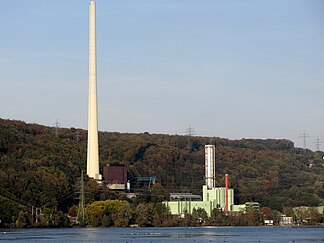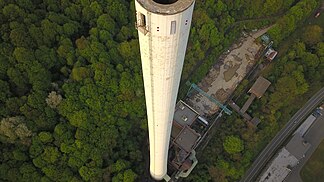Cuno power plant
| Cuno power plant | |||
|---|---|---|---|
| The Cuno power plant in Herdecke with the formerly listed boiler houses | |||
| location | |||
|
|
|||
| Coordinates | 51 ° 24 '1 " N , 7 ° 24' 28" E | ||
| country |
|
||
| Waters | Harkortsee , Ruhr | ||
| Data | |||
| Type | Combined gas and steam power plant | ||
| Primary energy | Fossil energy | ||
| fuel | Hard coal (1908–1970), secondary fuels (2001–2004), natural gas (1970–1982, from 2007) | ||
| power | Block H6: 417 megawatts (from 2007) | ||
| owner | Brand | ||
| Start of operations | 1908 | ||
| Chimney height | 240 m | ||
|
View of the combined cycle plant (right part of the power plant) |
|||
|
The 240 meter high chimney from above |
|||
The Cuno power plant is a power plant site for electricity and heat generation that has been in operation since 1908 and has been converted several times. The power plant is located in Herdecke on the Ruhr , which is dammed up here to form Harkortsee, and stands out clearly against the wooded Ardey slope . The 240 m high, often only briefly "Cuno" said chimney is visible from afar and is motorists on the A1 as a modern-day landmark stove Eckes. From May 2005, large parts of the power plant were demolished to make room for a gas and steam combined cycle power plant to be built at the same location , which has been in operation since 2007.
The Cuno power plant was named after the then mayor of Hagen, Willi Cuno , who co-founded the regional energy company " Elektromark ".
history
The Herdecker Kraftwerk was the first Elektromark plant in 1908 and the power station was one of the first pure steam turbine systems to work with German hard coal from the nearby Ruhr area . In the twenties , the plant was even considered exemplary across Europe because of its efficiency level of around 25 percent, which was estimated to be particularly high at the time .
After the First World War , Klaus Thormaehlen developed the pulverized coal combustion for this location and the first four pulverized coal boilers were successfully put into operation in 1927.
In 1932, Germany's first melting chamber furnace was inaugurated in the Cuno power plant . Several extensions and modernizations took place in the period after the Second World War .
The new "Block H2" has been delivering electrical power from hard coal since December 3, 1962 with a net output of 90 MW . But in 1970 the firing was switched to natural gas because coal had previously become very expensive as a fuel.
In 1982, precisely at the time of the broad public discussion about acid rain and forest death , the switch back to coal took place, which was very controversial on site because of the more harmful emissions at the time. Due to the renewed coal firing and the tightened legal situation , the construction of the approximately 240 meter high chimney became necessary, which has shaped the landscape ever since . To start up the turbine, natural gas was used via a pipeline or, in the event of a supply interruption, oil, which was stored locally in two tanks. From 1983 block H2 also supplied district heating for Herdeck industrial and commercial enterprises as well as private households.
After sustained strong protests, including from citizens' groups , a flue gas desulphurisation system (FGD), which was very modern at the time, went into operation in 1988 , which filtered out around 90% of the sulfur dioxide contained in the flue gas . The REA worked in combination with electrostatic precipitators and denitrification systems.
After the power plant had reached its economic lifespan towards the end of the 1990s , it was operated for a few years depending on the season and consumption. Most recently, from 2001, secondary fuels such as animal meal and carpet scraps were also burned with special permits in order to reduce costs .
On March 5, 2004, the hard coal-fired block H2 (P electrical = 86 MW, P thermal = 25 MW) in the Cuno thermal power station officially generated its last kilowatt hour, was held as a cold reserve for a transition period and was then demolished in 2005. In total, Block H2 has supplied around 17.5 million MWh of electrical energy since 1962 . In the late summer of 2004 a natural gas cogeneration plant , consisting of two Deutz 20-cylinder natural gas engines and two steam boilers, was put into operation to maintain the district heating supply after the main block was closed .
In order to be able to provide evidence of the open space required for the approval procedure for a new 400 MW gas power plant at the same location, all but the listed buildings were demolished from May 2005. In order to benefit from subsidies, the new system must be operational as early as 2007. With the exception of Block H2 and the listed parts, the existing system was gutted in 1998/1999 for a new building that was discussed at the time and which was not realized.
The gas and steam turbine (CCGT) plant was developed together with the Norwegian Statkraft . In the combined process, the energy is converted into electricity in a 270 MW gas turbine with a downstream waste heat boiler and a 147 MW steam turbine. The supply of natural gas is carried out of the transmission system of Gascade . As the responsible network operator , Enervie Vernetzt is responsible for the electrical grid connection at high voltage level .
Monument protection and tourism
The brick facades of the old boiler houses VI and VII stood up to take back part of the upper monument authority in Münster in February 2006 as industrial monuments under preservation . The reason for the lifting of the monument protection was that it was economically unacceptable for the company. As part of the Route of Industrial Culture , the buildings were also a tourist attraction in the Ruhr Valley. The instruction to lift the monument protection should be linked to the establishment of a small, publicly accessible documentation / information center on the history of energy use at the site. However, this was never opened.
Nowhere else to see was the type of inclined elevator that connected the plant with the freight railway siding higher up on the Ardeyhang , a construction by MAN . The inclined elevator for coal freight cars was also demolished in May 2005, although it was unique in Germany.
According to the former operating company, the chimney measures 240 meters and stands on a 20-meter-high elevation. It is not under monument protection, but there is a nesting box for peregrine falcons at a height of about 80 m , in which several generations have raised offspring after successful resettlement. The arriving and departing birds can be easily observed with binoculars from the ground during the breeding season .
See also
- Koepchenwerk , Hengstey run-of-river power station (neighboring power stations)
- List of decommissioned power plants in Germany
location
- Address: Mark-E Aktiengesellschaft, Cuno-Heizkraftwerk Herdecke, Wetterstrasse 111, 58313 Herdecke
- Public transport: Stop "E.-Werk-Mark", Herdecke
literature
- Wolfgang Kessler: Cuno is changing - a power plant location is changing its face . - Article in: Herdecker Blätter, Issue 23 (January 2006), pages 16-23
- Willi Creutzenberg: "Be careful! Build tall chimneys! - Highlights from the hundred-year history of the Cuno power plant in Herdecke". - Part 1 in: Herdecker Blätter, Heft 24 (December 2006), pp. 22–31
- Willi Creutzenberg: "Be careful! Build tall chimneys! - Highlights from the hundred-year history of the Cuno power plant in Herdecke". - Part 2 in: Herdecker Blätter, Issue 25 (December 2007), pp. 6–15
Web links
Individual evidence
- ↑ By Klaus Görzel: Cuno sticks up uselessly. Retrieved September 21, 2017 .
- ↑ Improved market situation: the operating time of the Mark-E gas and steam turbine power plant Herdecke more than doubled in 2019. Enervie , February 11, 2020, accessed May 31, 2020 .
- ↑ List of power plants. Federal Network Agency , April 11, 2020, accessed on May 31, 2020 .




